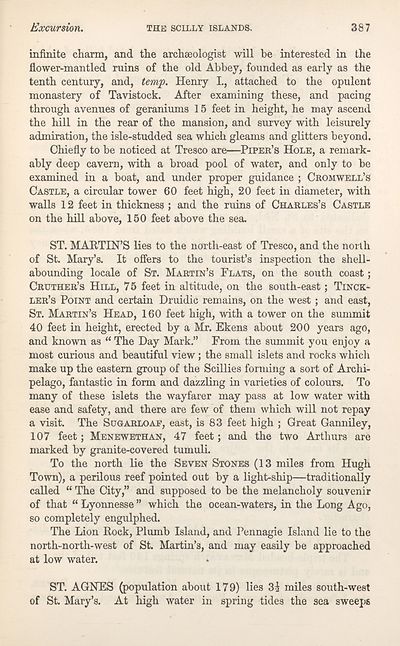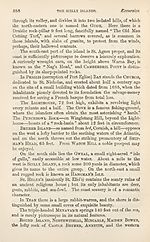Download files
Complete book:
Individual page:
Thumbnail gallery: Grid view | List view

Excursion.
THE SCILLY ISLANDS.
387
infinite charm, and the archaeologist will he interested in the
flower-mantled ruins of the old Abbey, founded as early as the
tenth century, and, temp. Henry I., attached to the opulent
monastery of Tavistock. After examining these, and pacing
through avenues of geraniums 15 feet in height, he may ascend
the hill in the rear of the mansion, and survey with leisurely
admiration, the isle-studded sea which gleams and glitters beyond.
Chiefly to be noticed at Tresco are—Piper’s Hole, a remark¬
ably deep cavern, with a broad pool of water, and only to be
examined in a boat, and under proper guidance ; Cromwell’s
Castle, a circular tower 60 feet high, 20 feet in diameter, with
walls 12 feet in thickness ; and the ruins of Charles’s Castle
on the hill above, 150 feet above the sea.
ST. MAETIN’S lies to the north-east of Tresco, and the north
of St. Mary’s. It offers to the tourist’s inspection the shell-
abounding locale of St. Martin’s Flats, on the south coast;
Cruther’s Hill, 75 feet in altitude, on the south-east; Tinck-
ler’s Point and certain Druidic remains, on the west; and east,
St. Martin’s Head, 160 feet high, with a tower on the summit
40 feet in height, erected by a Mr. Ekens about 200 years ago,
and known as “ The Day Mark.” From the summit you enjoy a
most curious and beautiful view; the small islets and rocks which
make up the eastern group of the Scillies forming a sort of Archi¬
pelago, fantastic in form and dazzling in varieties of colours. To
many of these islets the wayfarer may pass at low water with
ease and safety, and there are few of them which will not repay
a visit. The Sugarloaf, east, is 83 feet high ; Great Ganniley,
107 feet; Menewethan, 47 feet; and the two Arthurs are
marked by granite-covered tumuli.
To the north lie the Seven Stones (13 miles from Hugh
Town), a perilous reef pointed out by a light-ship—traditionally
called “ The City,” and supposed to be the melancholy souvenir
of that “ Lyonnesse ” which the ocean-waters, in the Long Ago,
so completely engulphed.
The Lion Rock, Plumb Island, and Pennagie Island lie to the
north-north-west of St. Martin’s, and may easily be approached
at low water.
ST. AGNES (population about 179) lies 3i miles south-west
of St Mary’s. At high water in spring tides the sea sweeps
THE SCILLY ISLANDS.
387
infinite charm, and the archaeologist will he interested in the
flower-mantled ruins of the old Abbey, founded as early as the
tenth century, and, temp. Henry I., attached to the opulent
monastery of Tavistock. After examining these, and pacing
through avenues of geraniums 15 feet in height, he may ascend
the hill in the rear of the mansion, and survey with leisurely
admiration, the isle-studded sea which gleams and glitters beyond.
Chiefly to be noticed at Tresco are—Piper’s Hole, a remark¬
ably deep cavern, with a broad pool of water, and only to be
examined in a boat, and under proper guidance ; Cromwell’s
Castle, a circular tower 60 feet high, 20 feet in diameter, with
walls 12 feet in thickness ; and the ruins of Charles’s Castle
on the hill above, 150 feet above the sea.
ST. MAETIN’S lies to the north-east of Tresco, and the north
of St. Mary’s. It offers to the tourist’s inspection the shell-
abounding locale of St. Martin’s Flats, on the south coast;
Cruther’s Hill, 75 feet in altitude, on the south-east; Tinck-
ler’s Point and certain Druidic remains, on the west; and east,
St. Martin’s Head, 160 feet high, with a tower on the summit
40 feet in height, erected by a Mr. Ekens about 200 years ago,
and known as “ The Day Mark.” From the summit you enjoy a
most curious and beautiful view; the small islets and rocks which
make up the eastern group of the Scillies forming a sort of Archi¬
pelago, fantastic in form and dazzling in varieties of colours. To
many of these islets the wayfarer may pass at low water with
ease and safety, and there are few of them which will not repay
a visit. The Sugarloaf, east, is 83 feet high ; Great Ganniley,
107 feet; Menewethan, 47 feet; and the two Arthurs are
marked by granite-covered tumuli.
To the north lie the Seven Stones (13 miles from Hugh
Town), a perilous reef pointed out by a light-ship—traditionally
called “ The City,” and supposed to be the melancholy souvenir
of that “ Lyonnesse ” which the ocean-waters, in the Long Ago,
so completely engulphed.
The Lion Rock, Plumb Island, and Pennagie Island lie to the
north-north-west of St. Martin’s, and may easily be approached
at low water.
ST. AGNES (population about 179) lies 3i miles south-west
of St Mary’s. At high water in spring tides the sea sweeps
Set display mode to:
![]() Universal Viewer |
Universal Viewer | ![]() Mirador |
Large image | Transcription
Mirador |
Large image | Transcription
| Antiquarian books of Scotland > Adventure and adventurers > Black's guide to the counties of Dorset, Devon, & Cornwall > (432) |
|---|
| Permanent URL | https://digital.nls.uk/142591563 |
|---|
| Description | Thousands of printed books from the Antiquarian Books of Scotland collection which dates from 1641 to the 1980s. The collection consists of 14,800 books which were published in Scotland or have a Scottish connection, e.g. through the author, printer or owner. Subjects covered include sport, education, diseases, adventure, occupations, Jacobites, politics and religion. Among the 29 languages represented are English, Gaelic, Italian, French, Russian and Swedish. |
|---|

